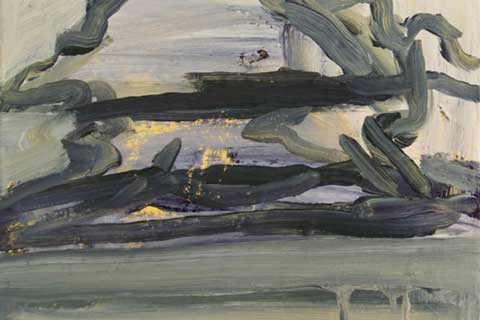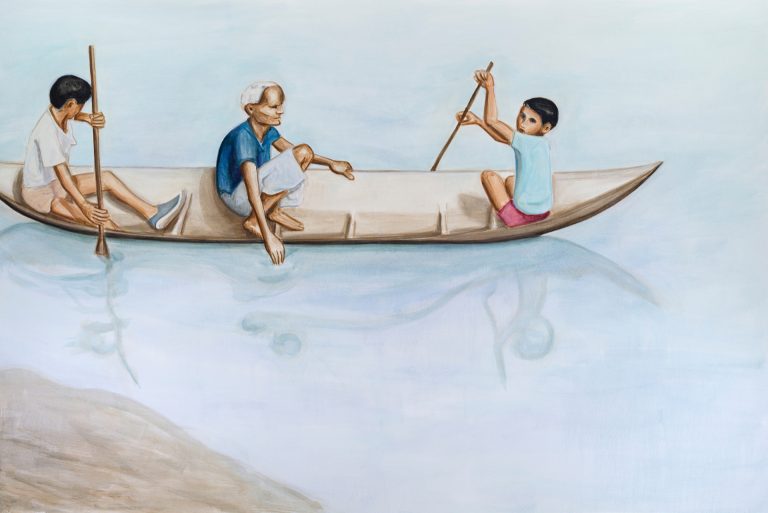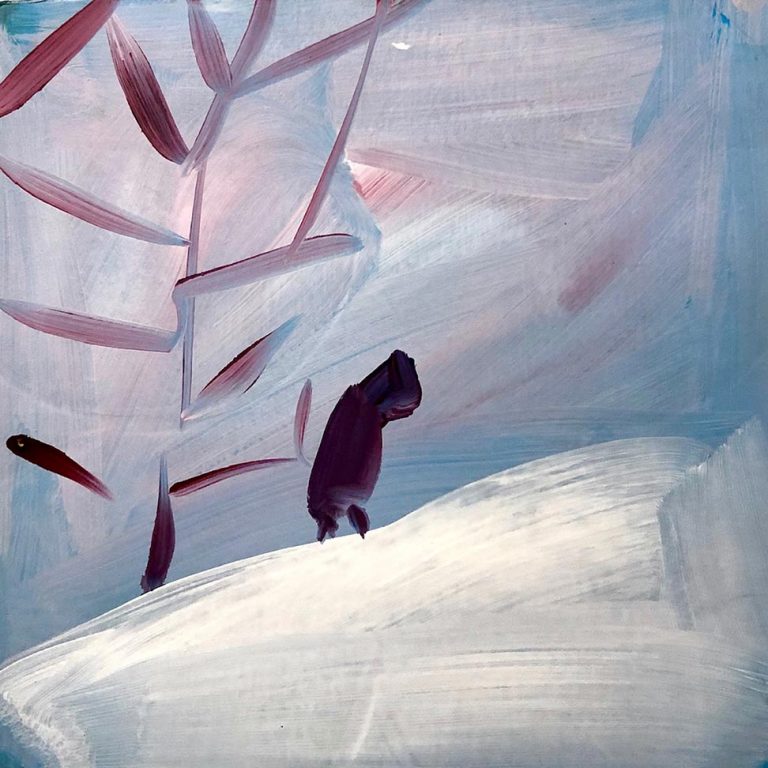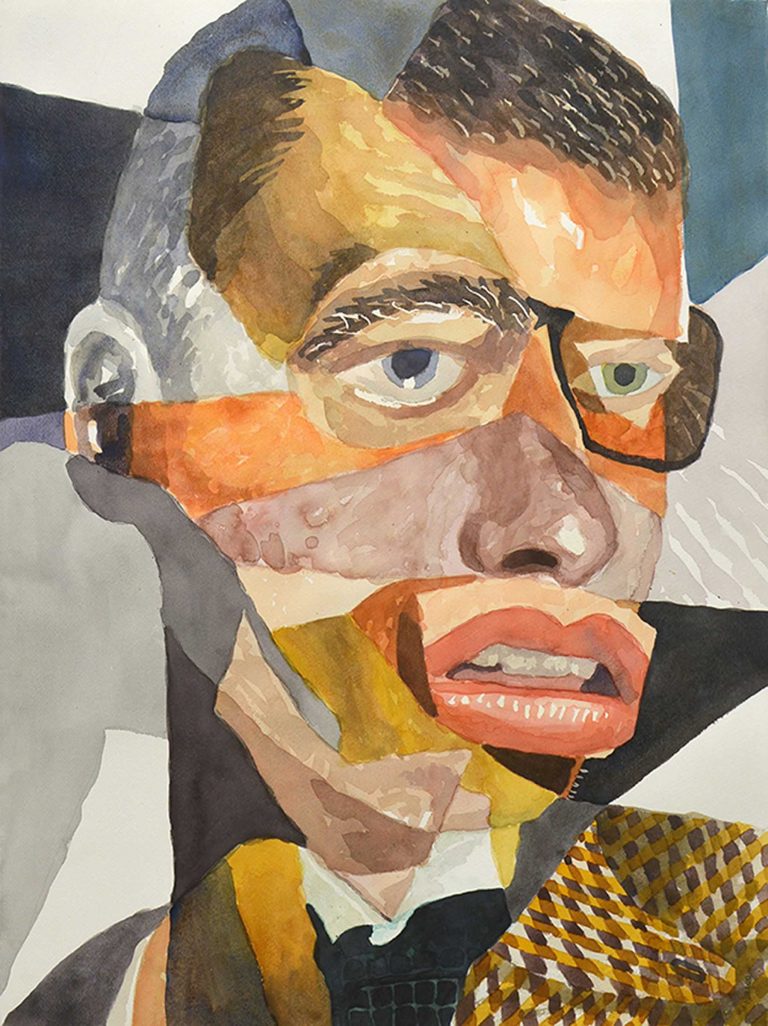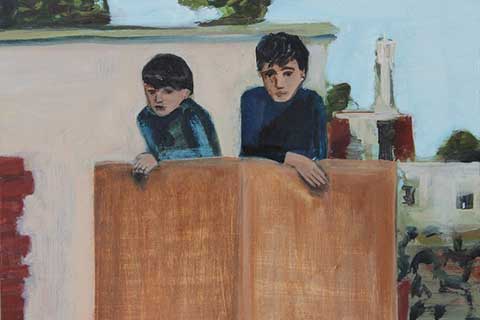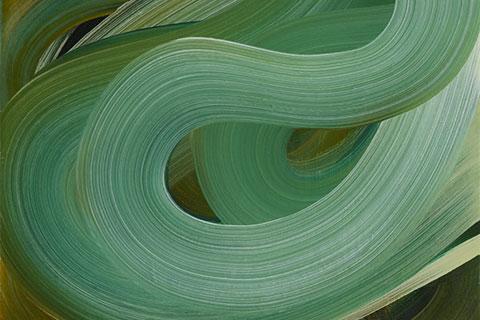Simon Carter in conversation with Nicholas Middleton

Nicholas Middleton: When I was looking at your work earlier today in preparation, it seemed to me that all your work is dedicated to landscape and I wondered if you had any thoughts on what landscape actually means in the contemporary world, if that’s not too big a question?
Simon Carter: That’s a really interesting question. Historically Constable, for example was fighting against the low position of landscape painting in the painting hierarchy and you would think now we had got rid of that hierarchy, you can do what you want, but landscape still occupies that low position, partially because it is the subject of Sunday painting. I suppose I am a landscape painter, but I think what I am doing is using the landscape of my immediate surroundings as a sounding board for thoughts, so if I go somewhere and see a great painting or see something that really engages me, I can come back to the landscape and find somewhere in the landscape that corresponds in some way to what I have looked at and use that. It is like an encyclopedia of possibilities.
But as soon as you say you are a landscape painter people put you right down to bottom of the painting ladder. It has an interesting history and maybe it has an unfortunate history…
NM: I think it is interesting thinking of the history of 20th century painting that someone like de Kooning used the nude as an arena to explore the possibilities of painting and it seems that a lot of artists retreated to the studio to do that, without engaging with the outside world. I can see something happening with your work where you are using landscape as a space for experimenting with paint. That’s more of an observation than a question.
SC: I think that is true. I don’t find that I can just ‘retreat to the studio’ and generate paintings by the act of painting. I need some kind of sounding board, so most mornings I go out and do 2 or 3 drawings, not necessarily drawings directly connected with paintings I’m doing. But you are allowing this external ‘something’ into the painting process all the time.
NM: You work in, perhaps not a traditional way, but your process takes in observation, working from the motif in front of you and then that sketch goes on somewhere else. So I was thinking about the function of the sketch in your work. Do you ever exhibit the sketches as themselves or are they just a stepping stone to the painting?
SC: I do sometimes exhibit the sketches and drawings but there are a lot that I wouldn’t because they are not complete in themselves. Occasionally you make one and it just seems complete and I think you can then take that out of the process.
I agree with you that what I do is quite traditional; I don’t think there is anything extraordinary in what I do at all. The fact that I go out, make observational drawings, drawings which I sometimes square up and use in the paintings. So in a sense it is a very traditional process.
NM: I wondered whether the drawings were more specifically an aide-memoire to your experience or how it relates to the primary experience and acts as a bridge between that and the painting.
SC: Auerbach said that the drawings were there to remind him what it was like being outside that day. I’m not sure that is exactly what I am doing. I make the drawing in direct response to the landscape and then come back to the studio and surprise myself by what information I have put in the drawing. So it is like uncovering things; uncovering marks or an instinctual response. The drawings happen very quickly, I might do 4 or 5 in half an hour, and you are uncovering an unmeditated response to something. That’s what feeds into the painting. It does remind you of the fact that it was the sea or the beach but that is not their main reason.
NM: When you were talking about the sketches and the speed that you do them, one thing I identify with your work is the appearance of rapidity. I wondered how hard won that was? When thinking of an artist such as Manet his work often has that appearance of the immediacy of the mark-making yet we know the process that it takes to get there. I see in some of your painting there are clearly layers and erasures…
SC: I do like that speed that paint goes onto the canvas. There is a language to do with that speed and almost offhandedness in a way, but it’s a long process which takes you there. Under each of these paintings there are dozens of other tries at that painting. You gradually find that little group of marks that say the painting, so I’d like to feel that the painting has almost gone on in one gesture. But underneath that you have rehearsed it through drawings, put it on, scraped it off. Auerbach seems to put great store in that dogged, long drawn out process but I think it is just the process you have to go through to arrive at the painting. Painting is a hard thing and it takes a long time to get it.
I try to keep the paint close to the surface, obviously in the smaller paintings any build up of paint is more noticeable but I like to keep the paint close to the surface so when it does happen it feels like a fresh surface.
NM: Is part of that freshness to do with what you are trying to convey about the experience, is there an analogy there?
SC: Yes. You can tend to go around allowing in only enough information for you to navigate your way through the world. As soon as you stop and really start to consider the world, it is an extraordinary and strange place. It is that moment when you are caught out by how something looks; when you look at something and it is almost as if you are seeing it for the first time whereas you have cycled past it every morning for the last ten years. You see something that catches you out. It is that fresh unmeditated view of the world, you are looking at the world as if you have opened your eyes for the first time. Obviously painting is a cultural activity and we learn ways of seeing but it is that kind of immediacy that it is about.
NM: I wonder whether you can say something about the use of colour in your work. They all seem to be within a relatively limited spectrum, there is not a huge range of…
SC: Every now and then I do get bothered by that and I think I am unnecessarily limiting what I do. For the last eighteen months to two years I have consciously just made drawings from the beach. So I am limiting subject but also I am limiting colour in that sense. The colour really happens in the studio. I make black and white drawings outside with maybe a little colour in them. The colour is remembered…is it emotion?.. it is something remembered from the day and you hunt for this colour. I know at the moment it comes out as turquoises, greys and dark mixtures of blue and some kind of earth colour. So it is limited but I think that is partially to do with subject matter. I live on the east coast and there is a certain maritime light and I’m trying to be honest to that as well.
NM: As an artist, giving yourself limits can really help to define what it is you are trying to do because working with representation, however you define it, there is so much out there in the world you can never put it all in the work so if you come to a decision about where those limits are it becomes a lot more fruitful.
SC: I think you are right. You paint in black and white but I never think of your paintings as black and white paintings because it feels like the whole world when you look at them. It doesn’t feel at all limited but because those limitations are in place it has given you an area to address that world.
NM: It gives you a space to tap into those things that you are interested in dealing with and cuts out some of the extraneous things that are not what the work is about.
SC: I have always thought of the paintings of Franz Kline as black and white, but when you said that, that is the first time I thought, yes, your paintings are actually black and white. I had always thought of them as representations of the world as it is; but obviously they are not.
One dimension of all the work here is 30cm so what you can do with the brush in relation to the size of canvas is one kind of thing whereas if you work on a 6 foot canvas the relation of the brush to the size of the canvas is something different. So there are limitations in these paintings and it does bother me sometimes that they all seem to come out the same colour but that is part of the process of these paintings and I don’t want to force it on to something else, but in a years time it will be somewhere else.
NM: In terms of your daily practice one of the things I was interested in is specifically where you live on the coast. Now I don’t know much of your personal background but does living on the edge, where the land meets the sea, come before you were a landscape painter or did you choose to live there because…
SC: No, I actually grew up there so it is difficult to separate out what is adopted and what is just that background of growing up. The places I go to now are the places I have been going to since I was little. So I have never made a decision, it is just part of what I am.
NM: But you did study in London.
SC: I found that quite difficult.
NM: Did that effect your work?
SC: It toughens you up. I did find London very difficult. I did sixth form at school, a foundation course at Colchester and then three years at North East London Polytechnic. I think if I had done those three years ten years further on I could have dealt with it better. I was using some of the subject matter from east London. The studios looked out from the fourth floor across Plaistow. So I was using bits of that information but was also gathering up drawings from home. It wasn’t the easiest of times but you still remember things tutors said and I’m still in touch with one or two of them, so it wasn’t all bad.
NM: Thinking about where you live and how that influences your work, I wonder about your relationship to the land; you have an allotment and grow food and I wonder whether there is an element of that which forces you to be perhaps more aware of the seasons. Does that have any bearing?
SC: I think perhaps it does but I’m not sure I could consciously explain it. After I left college I worked for sixteen years as a part-time postman. I got up at 4 and worked through until about 9.30, six days a week so whatever the weather you had to be out in that time slot, so that facing up to the weather probably came from being a postman. The seasonal things are quite important to me as well. Marking the turning of the year probably does have a part to play in the paintings.
NM: In contemporary life it is useful to have that awareness.
SC: It does make you realise what a precarious life we live. I hope there is a kind of humility in the paintings and a recognition of our position in the world.
NM: In your recent exhibition at Messum’s, there were a number of paintings with a figure. Is that a Romantic device of putting that figure against the world or in the world? It seems to be a recent development.
SC: It is a recent thing. I can now read that back into some of the earlier work where figures appear. I think it has Romantic attachments; as soon as you put a figure in front of an ocean you are reminded of Caspar David Friedrich. One piece that I found particularly significant was a van Gogh drawing of himself walking along a road, the painting was destroyed in the war, and that is the painting that Bacon then used to make his van Gogh paintings. So you have the artist in the landscape. But also, I go to church and I have a faith but I don’t feel there is any way I can deal with that kind of subject matter directly. It seems to have gone out of contemporary painting. In a sense putting that figure in centrally under a horizon with a boat on the horizon is a very low-key… I was going to say lame, attempt at… it’s not composed; the figure is in the middle, the horizon is at the top, the boat is in the middle of that; it has a logic to it which, if you wander around the National Gallery, that logic is in the crucifixion paintings. But I don’t want to make any claims for what I’m doing on that level.
NM: I think it’s also to do with scale. Some of the paintings which have less definable or recognisable elements in, whether clouds or water, without that figure the scale can be elastic. Once the figure is in the scale is very much defined.
SC: That is a good point. One of the paintings, not actually here in this group, did have a small figure in the front. It stayed there for a while, then I painted it out as it didn’t seem to work. But you are right, as soon as you put that in you know the distance between yourself and that figure and the figure and what is beyond the figure. That was the problem I had with it, this figure seemed to over-define the scale of the painting. But it’s something I’m still working on.
NM: I think it is a very delicate balancing act, particularly when dealing with paintings of the world out there, using a figure can skew how a picture is read, adding an element of narrative that perhaps one wants or doesn’t want.
SC: When you look at a painting that doesn’t have a figure in it the viewer is almost the presence in the painting. As soon as you put a figure in a painting you are outside that space because of the scale of the figure.
NM: But if you put a figure in, in the right way, you can then identify with that figure in the painting. In some of Friedrich’s work you have that element of identifying with being in the painting. So sometimes it can be a barrier and sometimes be a way in.
SC: It is a much more complicated relationship with the painting. In some of those larger paintings the figure went in and out lots of times. Some of them ended up with the figure almost transparent and you can see what is going on beyond it. It’s a more difficult relationship with the painting, but in a sense that’s good because you want to set yourself problems. You don’t want to understand what you do and then continue doing it. You want to force yourself to rethink what you are doing each time.
NM: Finally I would like to ask you something about Constable. With a knowledge of art history Willy Lott’s Cottage becomes almost an iconic presence and before reading the titles I could recognise a couple of the paintings in the current exhibition as having that link. What you said earlier about landscape becoming almost a cliche that is best avoided if you are working with any seriousness in contemporary art…
SC: That is the view, isn’t it. I don’t live that far from what is now classified as ‘Constable Country’ and also Ipswich Museums, which are not far from me, have a very good collection, I think they have eleven Constable paintings, including an absolute beautiful oil sketch of Willy Lott’s House. I guess it’s always been part of my psyche. I did a show with Ipswich Museums in 2007 looking at Constable, going back to Flatford and Dedham making drawings but also drawing from the paintings they own and that evolved into a whole series of paintings.
Willy Lott’s House is probably the most famous farm house in Britain, because Constable painted it. He is a fantastic painter but very misunderstood as well…
NM: Your saying ‘Constable Country’, the heritage industry has a tendency to de-radicalise him. 200 years ago Constable was on the cutting edge, the power gets stripped out by the uses…
SC: In reproduction it does seem to have that early 19th century veneer. The actual paintings are far more radical than the reproductions make them seem. There was an exhibition recently at the Royal Academy looking at Gainsborough, Constable and Turner and the ‘Leaping Horse’ was there, and that is a mad piece of painting. Look at the horizon on the right-hand side, there are little dabs and dashes and dots of paint, it is a little microcosm of 20th century painting on the horizon.
When I put the house in I think it is a reminder of art history. I’m not mimicking what Constable did, it is just an iconic shape. Also these sea and cloud paintings that are here I have realised quite recently are probably to do with those Constables cloud studies.
NM: Thank you.
May 2013



